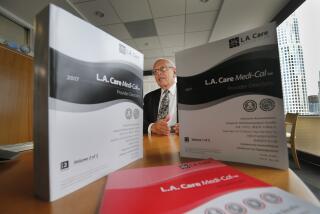Major Changes OKd in Care for Indigent
SANTA ANA â The Board of Supervisors on Tuesday approved major changes in medical services for indigents in a way that local doctors and hospitals hope will improve care while relieving pressure on emergency rooms.
The plan, under development for several years, is designed to enhance primary and preventive care for the nearly 28,000 people in the countyâs indigent health program.
Indigent patients with chronic medical conditions such as diabetes and heart disease will be assigned to one of a dozen private clinics, where doctors will monitor their condition and provide referrals if needed.
Doctors and health officials said the changes mark a vast improvement over the current system, which leaves some patients without care until they require emergency-room treatment.
âThis provides patients with a âmedical homeâ where they can get their problems addressed early on,â said Ronald DiLuigi, assistant director of the countyâs Health Care Agency. âWe donât want their conditions deteriorating to the point where they need a trip to the emergency room.â
The changes take a page from the âmanaged careâ system already familiar to users of health maintenance organizations, and include the largest-ever increase to the budget for indigent health care, which will rise by 16% to $40.8 million.
âThis is very significant, because it provides a stronger safety net for people without insurance,â said Board of Supervisors Chairman William G. Steiner. âUltimately, the taxpayers benefit through lower emergency room costs . . . and by preventing medical problems from becoming chronic.â
Most of the increased spending will go to pay doctors, clinics and hospitals providing the care. Unlike other California counties, Orange County does not operate any public hospital, and relies on a fragile network of private medical centers and physicians to care for the poor--even though there isnât enough funding to cover all the costs.
Sam Roth, assistant director of the Orange County Medical Assn., said the extra county funding might entice more doctors into participating in the indigent care program. He said the new system might also reduce the costs of hospitals that currently treat poor patients who show up in their emergency rooms, often with illnesses that could be treated outside a hospital.
âThis is moving to an outpatient setting, where [care] is less costly,â Roth added. The clinics âwill be the place to go to get primary care instead of waiting until you get seriously ill.â
The medical community has been pushing for the changes for years, but it wasnât until this year that funding became available.
Most of the added $6 million came from state health funding that is tied to local sales taxes and motor vehicle fees. âWe are beginning to see the benefits of a strong economy,â DiLuigi said.
The Health Care Agency is now in the process of selecting the clinics and determining which patients will take part in the new system. Officials estimate that 9,000 to 13,000 people in the indigent care program suffer from âchronicâ medical conditions, but it is unlikely that all of them will be immediately assigned to a clinic, because funding is limited.
Janice Wirth, a program manager with the Health Care Agency, said the clinics will make sure that a diabetic receives periodic eye and blood tests and is referred to a specialist if necessary.
âThe whole goal is to avoid an episode in which [the patient] goes into a diabetic coma and winds up in the emergency room,â she said.
The indigent care program generally serves adults aged 64 or younger, who have yet to qualify for Medicare and lack the income to buy private insurance.
More to Read
Sign up for Essential California
The most important California stories and recommendations in your inbox every morning.
You may occasionally receive promotional content from the Los Angeles Times.











